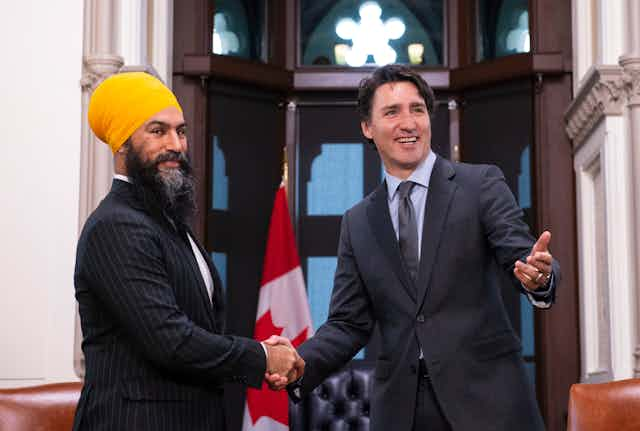Signed in March 2022, the supply-and-confidence agreement between the governing Liberals and the opposition New Democrats has already led to significant social policy expansion, including the adoption of the Canadian Dental Care Plan.
The deal eased the uncertainty facing Prime Minister Justin Trudeau’s minority government while allowing the NDP to take credit for some of the government’s social policy announcements.
But the future of the deal has been called into question in recent months. That’s because of the Trudeau government’s failure in 2023 to deliver on pharmacare, a central aspect of the March 2022 agreement.
With the deadline for a pharmacare bill recently extended until March 1, it’s helpful to look back at the origins of the supply-and-confidence agreement as we examine its fate in the year ahead.
Read more: Politicians come and go, but the clock is now ticking on long-promised pharmacare
Past agreements
Inter-party agreements in Canadian Parliament are extremely rare. Apart from the 1972 agreement between the Liberals and the New Democrats, there had never been an alliance between federal political parties in Canada before the 2022 agreement between Trudeau and NDP Leader Jagmeet Singh.
Such supply-and-confidence agreements are common elsewhere in the Commonwealth, but largely unprecedented in Canadian politics.
That’s why understanding the origins and impacts of this agreement — in which the NDP stays in opposition but supports the Liberal government, actively contributing to the implementation of key policy — is important.
Three factors at play
Three recent changes in federal politics help explain why both parties entered into the agreement in 2022.
First, since Trudeau became prime minister in late 2015, the Liberals and NDP have moved closer together. The two parties share more policies than in the past, especially in the area of social policy.
The COVID-19 pandemic, in particular, provided an opportunity for greater co-operation in the design and implementation of temporary and expansive emergency measures. In the aftermath of the pandemic, both parties agreed that new permanent federal programs are necessary, which is reflected in the details of the supply-and-confidence deal.
Second, public support over the last four years has left the Liberals and the NDP in a tricky situation. Liberal victory margins were small in 2019 and 2021, in both cases leading to a minority government.
Because both the Liberals and the NDP support an expanding social welfare program, the supply-and-confidence agreement provided both parties with a short-term political solution to both implement new key social policies and delay a federal election that could have led to a Conservative victory.

Third, although the Conservative Party consistently won the biggest portion of the popular vote in both 2019 (34.3 per cent) and 2021 (33.7 per cent) — and are ahead in recent polls — the competition is fierce on the political left.
Together, the more progressive parties — the Liberals, the NDP, the Bloc Québécois and the Green Party — have the support of a significant majority of Canadians, so each have to be seen as a credible political option to assert dominance over the others.
To this end, the supply-and-confidence deal has helped both parties develop and take credit for the expansion of social policies across Canada. It’s allowed the Liberals to maintain their identity as the defender of the middle class while the NDP has continued to oppose the wealthy and support the working class.
Political tensions
Both parties share a progressive identity that has facilitated their alliance. But currently, growing tensions between the Liberals and the NDP make the future of the agreement increasingly uncertain.
That’s largely because of the recent sharp decline in public support for the Liberals. The plunge has prompted Singh to become harshly critical of Trudeau in an effort to distance the NDP from an increasingly unpopular government and prime minister.
Singh has suggested the Liberals have only agreed to enact progressive policies that truly help Canadians when forced to do so by the NDP. He said in November 2023: “One of our MPs has described working with the Liberals like wrestling eels that are soaked in oil.”

Singh apparently doesn’t want to be regarded as a mere servant of the Liberals, keeping an unpopular government in power through the supply-and-confidence agreement.
That’s why he regularly reminds Canadians that he could pull the plug on the agreement if the Trudeau government fails to support the measures contained in the deal. Pharmacare is a case in point.
Death of the deal ahead?
Will the agreement be dissolved soon?
Terminating the agreement could help the NDP distance itself from the increasingly unpopular Liberals without necessarily triggering a federal election since the party could still support the Trudeau government in confidence votes through one-off deals.
Those types of agreements are much more common in Canada’s minority parliaments than formal legislative coalitions like the existing supply-and-confidence agreement.
The question for the NDP is whether it’s better off electorally with or without the agreement. Because public support for the NDP remains stable (or even slightly higher) while Liberal support has plummeted, that might make the Liberals cling longer to the agreement.
In the next few months, we’ll know whether this unusual agreement survives.

